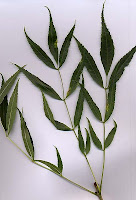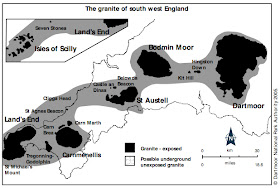 |
| Photo from Moabdave via Wikimedia Commons. |
As some readers know, I’m planning a trip from Wyoming to the West Coast, looking for interesting geo-destinations along the way. From my first stop in
Unaweep Canyon on the Uncompahgre Plateau in western Colorado, I will head west to visit salt anticlines in the
Paradox Basin. Continuing west on
I-70 through Utah, the absolute-number-one-most-beautiful stretch of interstate highway in my opinion, my next destination will be the San Rafael Swell, 15 miles west of Green River, Utah and 45 miles east of Salina, Utah.
Above, the kidney-shaped structure left center is the San Rafael Swell on the Colorado Plateau. Note the steeply-tilted sandstone strata that form the San Rafael Reef along the east and southeast flanks (click to view). Courtesy
ArcGIS Online. Below, the Swell in context; modified photo from NASA's
Visible Earth.
There are many great geo-resources for the Swell, both printed and online. I highly recommend Written in Stone’s lengthy and interesting post, Geology of the San Rafael Swell, for clear explanations of the Big Picture (critical for my understanding), fantastic small-plane aerial views of the Swell, abundant geologic illustrations, and discussions of stratigraphy and tectonic history. Rather than going into detail in this post, I refer you to WIS’s blog-tome.

Another resource I like a lot is Robert Fillmore’s
Geological Evolution of the Colorado Plateau (2011). Fillmore doesn’t hold back on the many controversies associated with the geology of this area. I look forward to careful reading and thinking about regional geologic history during spring evenings in the high desert, hopefully under starry skies.
Last week I was scanning Fillmore’s chapter on the Tertiary Period, when the following major section heading caught me by surprise:
The Laramide Orogeny
It was the Laramide Orogeny and resulting landforms, so striking and obvious and common across Wyoming, that turned me on to geology while a grad student in Botany, greatly enhancing my understanding and appreciation of landscapes and plant geography. But I guess I missed the bigger picture. All these years I had assumed that the Laramide Orogeny, a period of mountain-building 70 to 40 Ma (million years ago), was synonymous with the Rocky Mountains. So I was excited to discover that the San Rafael Swell is a Laramide uplift, one of the westernmost. However ... the style of Laramide deformation on the Colorado Plateau differs a bit from that of the Rockies to the east.
The San Rafael Swell and other uplifts on the Colorado Plateau are similar to Laramide structures in the Rocky Mountains in several ways: 1) they are broad-crested uplifts, often with steep flanks with hogbacks or flat-irons of more resistant strata; 2) they are partially bounded by high-angle reverse faults involving basement rocks (often reactivated older faults); 3) they are associated with adjacent downdrops (basins).
Sheep Mountain in southeast Wyoming (below, viewed from east) is typical of Laramide uplifts in the Rocky Mountains. It is bounded by a high-angle reverse fault on the east side, with Precambrian crystalline rocks now standing above the Cretaceous sedimentary strata of the adjacent downwarped basin. The break in slope near the base, highlighted by recent snow, marks the transition to Precambrian rocks above.

The big difference between Laramide structures of the Rockies and those further west is seen at the surface. Thick sedimentary strata of the Colorado Plateau “cushioned” the effects of faulting (Fillmore 2011), and the associated reverse faults typically do not reach the surface. The surface expression is a fold rather than a fault, specifically a monocline. Spectacular examples include the San Rafael Reef on the east side of the Swell, the Waterpocket Fold of Capitol Reef National Park, and Comb Ridge between Bluff and Mexican Hat, Utah. The Grand Canyon has cut through several monoclines, and deeply enough to reveal underlying reverse faults involving basement rocks.
 |
| Cross-section through San Rafael Swell. Note steep fold on east, and underlying fault in basement rocks (click to view). Courtesy Utah's Castle Country. |
April 18 update: The story behind the monocline may not be so simple. Kim at
All of My Faults are Stress-Related (pointed out by
Silver Fox) explains that there are "space problems" with this model, and goes on to discuss alternatives. Darn!
 |
| Interstate Highway 70 exits the Swell headed east by way of Spotted Wolf Canyon, which cuts though the steeply-dipping sandstones of the San Rafael Reef (dips of 89º in places!); photo by Dennis Adams, National Scenic Byways Online. |
In my readings about the Colorado Plateau, I also discovered that geologists consider Laramide mountains weird. Blakey and Ranney (2008) call the Rockies “one of the most enigmatic mountain ranges on Earth”. Apparently mountain ranges typically form along plate boundaries, due to collision, subduction and other kinds of plate jostling, but the Laramide uplifts of the Colorado Plateau and the Rocky Mountains are located up to 1000 miles east of the active western margin of North America. This is not easy to explain.
Fillmore (2011) doesn’t shy away from this paradox. He discusses in detail the most widely-accepted explanation of the inconveniently-intracontinental Laramide Orogeny. At some point there was a change in the angle of subduction of the oceanic plate moving under the west coast of North America. It became more shallow, resulting in deformation of continental crust far inland. Movement of basement-involved blocks, often along reactivated older faults, produced the broad anticlines, synclines and monoclines characteristic of the Laramide Orogeny. But not all the evidence fits neatly into this picture; Fillmore includes two competing variations of the story.
 |
| Along I-70 inside the San Rafael Swell. Courtesy ErgoSum88 via Wikimedia Commons. |
Things to do and see
The web is rich in travel tips for the San Rafael Swell. Several sites that I found useful are listed at the end of the post. Here is a sampling of the geo-stops I came across:
Cottonwood Wash/ Buckhorn Wash A 30-mile gravel road tours the northern part of the Swell. Utah’s Castle Country provides a brief road log of attractions (use link above).
A trip to the Wedge Overlook passes through dense “pygmy forest” ... piñon-juniper woodland. The Overlook looks over “Utah's Little Grand Canyon, with the tiny San Rafael River twisting along the canyon bottom. To the south, across the canyon, is the remote Sid's Mountain Wilderness Study Area, while the view down canyon towards the southeast takes in Window Blind Peak and the Southern Buckhorn Wash area. From this point, roads head east or west, providing more spectacular views for either drivers or hikers.”
Cleveland Lloyd Dinosaur Quarry (see CLDQ wikipedia page) is a dinosaur graveyard in the Jurassic Morrison Formation, like our own
Como Bluff in southeast Wyoming. The bones are well-preserved, but there are few intact skeletons -- just a massive jumbled collection of bones. For some reason the carnivorous
Allosaurus is especially common. The site has a Visitor Center, as well as tours and hiking trails.
Rock Art -- pictographs and petroglyphs -- can be found throughout the Swell. The most-visited site probably is the Buckhorn Wash Panel, along the main gravel road in the Swell (
photo to right).
Temple Mountain is the highest point along the San Rafael Reef -- the steeply-tilted sandstone strata along the east flank of the Swell. This was a uranium mining district; the old roads are now used for hiking, horseback riding and biking. I found the cool photo below, annotated to show the stratigraphy of the east flank of Temple Mountain, at
Cedar & Sand, a geology/adventure blog I was happy to discover. Go to
Goblin Valley for more great photos of the San Rafael Reef area.
Surreal hikes in narrow canyons “Keesle Country is a maze of canyons in the southwest corner of the Swell. A short hike or horseback ride into this road-less area will provide an introduction to its primitive character.” And then there is the popular
Little Wild Horse Canyon (photo to left).
I get the impression that the San Rafael Swell is a place to wander with destination unknown. “Most of this huge area [2000 sq mi] is open to the public and adventures are left only to the visitor's imagination” (from
Utah’s Castle Country). These are the kinds places I seek out, and I always wonder how long they will stay that way. I worry that the Swell might go the way of Moab to the east. Already it is being advertised as “Utah’s fastest growing tourist destination” ... sigh, better enjoy it now!
How to get there
 |
| You can access the San Rafael Swell from Interstate Highway 70 west of Green River, Utah. Courtesy GoogleEarth, click to view. |
 |
| Other ways to get into the Swell, courtesy Utah's Castle Country. Download full-sized PDF here. |
Additional Information
Websites
Books
Baars, Donald L. 2002. A traveler's guide to the geology of the Colorado Plateau. Salt Lake City: University of Utah Press. This is a series of road logs with brief introductions to each section. The logs are quite detailed, especially regarding stratigraphy, with frequent mileages. I'm hoping it will make me more confident in identifying formations.
Blakey, Ronald C. and Ranney, Wayne. 2008. Ancient landscapes of the Colorado plateau. Grand Canyon, AZ: Grand Canyon Association. This is a pretty amazing book, with maps (reconstructions) of the Colorado Plateau region and western North America from the late Precambrian on. The text is fairly non-technical, but with thorough Big Picture explanations of the geologic history of the Plateau region. Wayne Ranney also has a geology blog with many posts about the area -- Earthly Musings. I need to get busy perusing it.
Fillmore, Robert. 2010. Geological evolution of the Colorado Plateau of eastern Utah and western Colorado, including the San Juan River, Natural Bridges, Canyonlands, Arches, and the Book Cliffs. Salt Lake City: University of Utah Press. Probably I've raved enough about the depth of coverage in this book. It ends with nine tours (road logs).































































